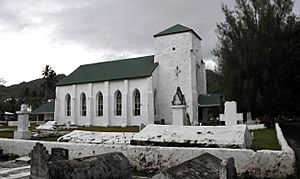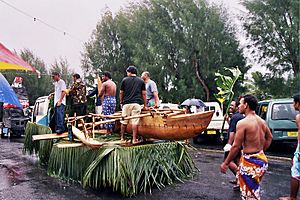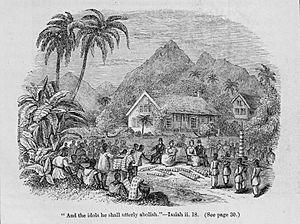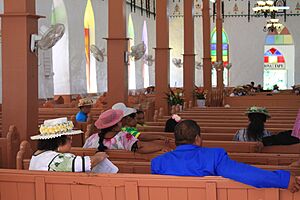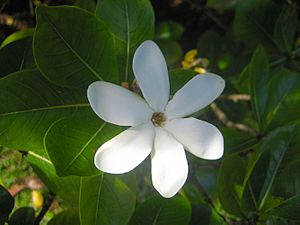Cook Islands facts for kids
Quick facts for kids
Cook Islands
|
|
|---|---|
|
Anthem: Te Atua Mou E
(English: "God is Truth") |
|
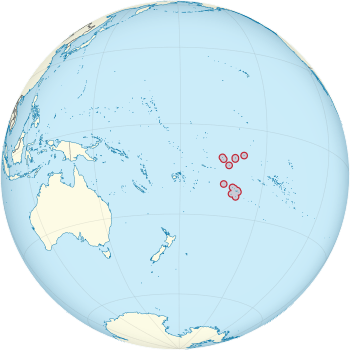 |
|
| Capital and largest city
|
Avarua 21°12′S 159°46′W / 21.200°S 159.767°W |
| Official languages |
|
| Spoken languages |
|
| Ethnic groups
(2016 census)
|
|
| Demonym(s) | Cook Islander |
| Government | Unitary constitutional monarchy |
|
• Monarch
|
Charles III |
|
• King's Representative
|
Sir Tom Marsters |
| Mark Brown | |
| Legislature | Parliament |
| Free association with New Zealand | |
|
• Self-governance
|
4 August 1965 |
|
• UN recognition of independence in foreign relations
|
1992 |
| Area | |
|
• Total
|
236.7 km2 (91.4 sq mi) (unranked) |
| Population | |
|
• 2021 census
|
15,040 (223rd) |
|
• Density
|
63.3/km2 (163.9/sq mi) (138th) |
| GDP (nominal) | 2020 estimate |
|
• Total
|
US$384 million (not ranked) |
|
• Per capita
|
US$21,994 (not ranked) |
| Currency | New Zealand dollar (NZD)Cook Islands dollar (formerly) |
| Time zone | UTC–10 (CKT) |
| Driving side | left |
| Calling code | +682 |
| ISO 3166 code | CK |
| Internet TLD | .ck |
|
|
The Cook Islands (in Rarotongan: Kūki ‘Airani) is an island country located in Polynesia. It's part of Oceania in the South Pacific Ocean. This country is made up of 15 islands, with a total land area of about 236.7 square kilometers (91 square miles). The ocean area around the Cook Islands, called its Exclusive Economic Zone, is huge, covering nearly 2 million square kilometers (757,000 square miles). The capital city is Avarua.
The Cook Islands governs itself but has a special partnership with New Zealand. This means they handle their own foreign affairs and defense. Even though they don't have their own army, New Zealand usually helps with their protection. Over the years, the Cook Islands has become more active in global matters. For example, a Cook Islander, Henry Puna, is currently the Secretary General of the Pacific Islands Forum. Most Cook Islanders are also citizens of New Zealand, but they have a special status as Cook Islands nationals. The Cook Islands has been an active member of the Pacific Community since 1980.
Most people in the Cook Islands live on the island of Rarotonga, with about 10,863 residents in 2021. The main airport, Rarotonga International Airport, is also on this island. In 2021, the total population was around 14,987 people. Many Cook Islanders also live in New Zealand and Australia. In 2018, over 80,000 people in New Zealand said they were Cook Islanders or had Cook Islands family. Australia's last census showed about 28,000 Cook Islanders living there. Tourism is the biggest industry for the Cook Islands, with over 168,000 visitors in 2018. Other important parts of their economy include pearls and exporting seafood and fruit.
Contents
Naming the Cook Islands
The Cook Islands are made up of 15 islands, each with its own local name in languages like Cook Islands Māori and Pukapukan. The first Europeans to see the islands were Spanish explorers in 1606, who called Rakahanga Gente Hermosa, meaning "beautiful people."
The islands are named after British Captain James Cook. He visited in the 1770s and named one island, Manuae, "Hervey Island." Later, the southern group of islands became known as the "Hervey Islands." In the 1820s, a Russian admiral named Adam Johann von Krusenstern used the name "Cook Islands" for the southern islands on a map. The name "Cook Islands" for the whole territory, including the northern islands, became official after New Zealand took control in the early 1900s.
The official name in Cook Islands Māori is Kūki ‘Āirani, which is a local way of saying the English name. In 2019, there were talks about changing the name to better show its "Polynesian nature," but it was decided to keep the English name and create a new Cook Islands Māori name instead. Discussions about this new name continued in 2020.
Cook Islands History
The Cook Islands were first settled around 1000 AD by Polynesian people. They are thought to have traveled from Tahiti, an island about 1154 kilometers (717 miles) northeast of Rarotonga.
The first European to see the islands was Spanish sailor Álvaro de Mendaña de Neira in 1595, who spotted Pukapuka. The first European to land was Pedro Fernandes de Queirós in 1606 on Rakahanga. British explorer Captain James Cook visited in 1773 and 1777.
In 1813, missionary John Williams was the first European to record seeing Rarotonga. The first European landing on Rarotonga was in 1814, but there was fighting between sailors and islanders. English missionaries arrived in 1821, and Christianity quickly became a big part of the culture. Many islanders are Christians today.
In the 1800s, the islands were a popular stop for whaling ships from the United States, Britain, and Australia. They came for water, food, and firewood.
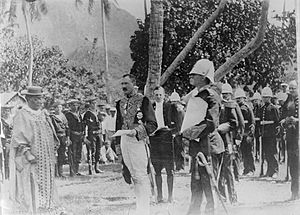
The Cook Islands became connected to the United Kingdom in 1890. This was mainly because British residents worried that France might take over the islands, as they had done with Tahiti. In 1900, the island leaders asked to become part of British territory. The islands officially became part of New Zealand in 1901. Since then, the Cook Islands has had a formal relationship with New Zealand.
During World War I, almost 500 men from the Cook Islands volunteered to fight. They joined New Zealand and Australian forces. Many faced difficult conditions, and some died from fighting or disease. After the war, many who returned also faced the influenza epidemic.
On August 4, 1965, the Cook Islands became self-governing. This day is celebrated each year as Constitution Day. Albert Henry became the first Premier.
In 2017, the Cook Islands created Marae Moana, which is one of the world's largest protected ocean areas. On September 25, 2023, the United States officially recognized the Cook Islands as a sovereign nation and started diplomatic relations.
Cook Islands Geography
The Cook Islands are in the South Pacific Ocean, northeast of New Zealand. They are located between American Samoa and French Polynesia. There are 15 main islands spread over 2.2 million square kilometers (850,000 square miles) of ocean. These islands are divided into two groups: the Southern Cook Islands and the Northern Cook Islands. The northern islands are coral atolls.
The islands were formed by volcanoes. The northern group is older and consists of six atolls, which are sunken volcanoes covered by coral. The climate is warm, ranging from moderate to tropical. From March to December, the Cook Islands can experience tropical cyclones, like Martin and Percy. The islands are home to two types of forests: the Central Polynesian tropical moist forests and the Cook Islands tropical moist forests.
| Island Group |
Island | Area (km2) |
Population Census 2021 |
Density per km2 |
|---|---|---|---|---|
| Northern | Penrhyn | 9.8 | 230 | 23.5 |
| Northern | Rakahanga | 4.1 | 81 | 19.8 |
| Northern | Manihiki | 5.4 | 207 | 38.3 |
| Northern | Pukapuka | 1.3 | 456 | 350.8 |
| Northern | Tema Reef (submerged) | 0 | 0 | – |
| Northern | Nassau | 1.3 | 92 | 70.8 |
| Northern | Suwarrow | 0.4 | 0 | – |
| Southern | Palmerston | 2.1 | 25 | 11.9 |
| Southern | Aitutaki | 18.3 | 1,776 | 97.0 |
| Southern | Manuae | 6.2 | 0 | - |
| Southern | Takutea | 1 | 0 | - |
| Southern | Mitiaro | 22.3 | 155 | 7.0 |
| Southern | Atiu | 26.9 | 382 | 14.2 |
| Southern | Mauke | 18.4 | 249 | 13.5 |
| Southern | Winslow Reef (submerged) | 0 | 0 | – |
| Southern | Rarotonga | 67.1 | 10,863 | 161.9 |
| Southern | Mangaia | 51.8 | 471 | 9.1 |
| Total | Total | 236.7 | 14,987 | 63.3 |
Note: The table lists islands from north to south. Population numbers are from the 2021 census.
Administrative Divisions
The Cook Islands has local councils on most of its inhabited outer islands. Each council is led by a mayor. The island of Nassau is governed by Pukapuka.
 |
 |
Aitutaki (including uninhabited Manuae) |
 |
 |
Atiu (including uninhabited Takutea) |
 |
 |
Mangaia |
 |
 |
Manihiki |
 |
 |
Mauke |
 |
 |
Mitiaro |
 |
 |
Palmerston |
 |
 |
Penrhyn |
 |
Pukapuka (including Nassau and Suwarrow) | |
 |
 |
Rakahanga |
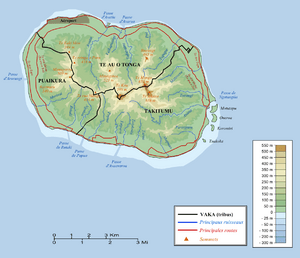
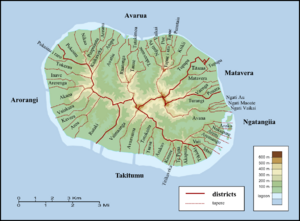
Rarotonga used to have three Vaka councils, but these were removed in 2008. At the smallest level, there are village committees. Nassau has an island committee that advises the Pukapuka Island Council.
Cook Islands Population
| Population pyramid 2011 | ||||
| % | Males | Age | Females | % |
| 0 | 85+ | 0 | ||
| 0.5 | 80–84 | 0.6 | ||
| 0.7 | 75–79 | 0.9 | ||
| 1.4 | 70–74 | 1.4 | ||
| 1.9 | 65–69 | 1.8 | ||
| 2.2 | 60–64 | 2 | ||
| 2.4 | 55–59 | 2.4 | ||
| 3 | 50–54 | 3 | ||
| 3.6 | 45–49 | 3.6 | ||
| 3.4 | 40–44 | 3.6 | ||
| 3.1 | 35–39 | 3.6 | ||
| 3 | 30–34 | 3.3 | ||
| 3.3 | 25–29 | 3.8 | ||
| 3.4 | 20–24 | 3.7 | ||
| 4.3 | 15–19 | 4.1 | ||
| 4.5 | 10–14 | 4 | ||
| 4.3 | 5–9 | 4.3 | ||
| 4.5 | 0–4 | 4.4 | ||
Births and Deaths
| Year | Population | Live births | Deaths | Natural increase | Crude birth rate | Crude death rate | Rate of natural increase |
|---|---|---|---|---|---|---|---|
| 2009 | 22,600 | 284 | 72 | 212 | 12.6 | 3.2 | 9.4 |
| 2010 | 23,700 | 286 | 92 | 194 | 12.1 | 3.9 | 8.2 |
| 2011 | 14,974 | 262 | 72 | 190 | 13.6 | 3.7 | 9.8 |
| 2012 | 19,500 | 259 | 104 | 155 | 13.3 | 5.3 | 7.9 |
| 2013 | 18,600 | 256 | 115 | 141 | 13.8 | 6.2 | 7.6 |
| 2014 | 18,600 | 204 | 113 | 91 | 11.0 | 6.1 | 4.9 |
| 2015 | 18,400 | 205 | 102 | 103 | 11.0 | 5.5 | 5.5 |
| 2016 | 17,434 | 242 | 87 | 155 | 12.5 | 4.5 | 8 |
| 2017 | 19,500 | 222 | 93 | 129 | 11.4 | 4.8 | 6.6 |
| 2018 | 18,600 | 232 | 121 | 111 | 12.5 | 6.5 | 6 |
| 2019 | 20,200 | 225 | 105 | 120 | 11.1 | 5.2 | 5.9 |
| 2020 |
Religion in the Cook Islands
In the Cook Islands, the church and government are separate. Most people are Christian.
About 62.8% of people are Protestant. The largest group is the Cook Islands Christian Church, with 49.1% of the population. Other Protestant groups include Seventh-day Adventists (7.9%), Assemblies of God (3.7%), and Apostolic Church (2.1%). The main non-Protestant group is Catholics, making up 17% of the population. The Church of Jesus Christ of Latter-day Saints accounts for 4.4%.
Cook Islands Economy
The Cook Islands' economy is greatly affected by its location. It is far from other countries, has limited resources, and can be hit by natural disasters. Tourism is the biggest part of the economy, making up about 67.5% of the country's income. The economy also gets help from foreign aid, mostly from New Zealand. China has also provided aid, helping to build things like the Police Headquarters. The Cook Islands is also trying to grow its farming, mining, and fishing industries.
Since 1989, the Cook Islands has become known for something called "asset protection trusts." These are ways for people to protect their money and property from legal claims in their home countries. The laws here make it difficult for creditors (people owed money) to get assets back. This is because creditors must travel to the Cook Islands and argue their cases under Cook Islands law, which can be very expensive. Unlike some other places, the Cook Islands often does not follow foreign court orders. It also keeps information about these trusts private. Taxes from these trusts make up about 8% of the Cook Islands' economy.
Infrastructure and Transport
There are eleven airports in the Cook Islands. One of them, Rarotonga International Airport, has a paved runway and is served by four passenger airlines.
Cook Islands Culture
Newspapers
Newspapers in the Cook Islands are usually printed in English, with some articles in Cook Islands Māori. The Cook Islands News has been published since 1945.
Language
The main languages spoken in the Cook Islands are English, Cook Islands Māori (also called "Rarotongan"), and Pukapukan. Cook Islands Māori has different dialects, like those spoken in Penrhyn, Rakahanga-Manihiki, Ngaputoru (from Atiu, Mitiaro, and Mauke), Aitutaki, and Mangaia. Cook Islands Māori is similar to Tahitian and New Zealand Māori. Pukapukan is similar to the Samoan language. Both English and Cook Islands Māori are official languages of the Cook Islands.
Music
Music in the Cook Islands is diverse. Christian songs are very popular, but traditional dancing and songs in Polynesian languages are also still loved.
Public Holidays
Art in the Cook Islands
Woodcarving
Woodcarving is a common art form in the Cook Islands. The islands in the southern group developed similar carving styles, but each island had its own special touches. Rarotonga is known for its unique "fisherman's gods" and "staff-gods." Atiu is famous for its wooden seats, while Mitiaro, Mauke, and Atiu are known for mace and slab gods. Mangaia is recognized for its ceremonial adzes. Many old carvings were taken by early European collectors or destroyed by missionaries. Today, people are working to teach young people about this important part of their heritage. Atiu has a strong tradition of crafts, including carving and fiber arts like tapa. Mangaia is known for its finely carved adzes and food pounders made from limestone.
Weaving
The outer islands are known for traditional weaving of mats, baskets, and hats. Women often wear beautiful rito hats to church. These hats are made from the soft, young fibers of the coconut palm and are very high quality. They are like the Polynesian version of Panama hats and are highly valued, especially by visitors from Tahiti. These hats are often decorated with tiny pupu shells, which are painted and sewn on by hand. While pupu shells are found on other islands, collecting and using them in art is a special skill of Mangaia. Weaving rito is a special skill of the northern islands: Manihiki, Rakahanga, and Penrhyn.
Tivaevae Quilts
A major art form in the Cook Islands is tivaevae. These are beautiful handmade patchwork quilts that often show island scenes. This craft was brought by missionaries' wives in the 1800s and became a popular group activity.
Contemporary Art
The Cook Islands has many talented modern artists, especially on the main island of Rarotonga. Some well-known artists include painter and photographer Mahiriki Tangaroa, sculptors Eruera (Ted) Nia and master carver Mike Tavioni, and painter Upoko'ina Ian George. Other artists include Tim Manavaroa Buchanan, Loretta Reynolds, Judith Kunzlé, Joan Gragg, Kay George (who also designs fabrics), Apii Rongo, Varu Samuel, and multi-media artist Ani O'Neill. Many of these artists have studied art in New Zealand and still have strong connections to the art scene there.
Andrea Eimke, based in Atiu, creates art using tapa and other textiles. She also co-wrote a book about tivaevae. Cook Islander artists living in New Zealand include Michel Tuffery, David Teata, Richard Shortland Cooper, Nina Oberg Humphries, Sylvia Marsters, and Jim Vivieaere.
The Bergman Gallery in Rarotonga is a main art gallery that shows works by Cook Islands artists. The Art Studio Gallery used to be run by Ian George and Kay George. There is also Gallery Tavioni and Vananga, run by Mike Tavioni. The Cook Islands National Museum also displays art.
Cook Islands Wildlife
- The national flower of the Cook Islands is the Tiare māori.
- The Cook Islands has many non-native ship rats and Kiore toka (Polynesian rats). These rats have greatly reduced the bird population on the islands.
- In 2007, 27 Kuhl's lorikeet birds were brought to Atiu from Rimatara. Old stories and fossils show that this bird used to live on at least five of the southern islands. They likely disappeared because too many were hunted for their red feathers.
- The waters around the islands are home to the Peppermint angelfish. These fish are common, but they are very hard to catch. Because of this, they are one of the most expensive marine aquarium fish, costing around US$30,000.
Cook Islands Sport
The Cook Islands has competed in the Summer Olympic Games since 1988, but they have not yet won a medal. Rugby league is the national and most popular sport in the Cook Islands.
Images for kids
-
Aerial photograph of Pukapuka
-
Tapuaetai (One Foot Island) on the southern part of Aitutaki
-
Beach on Rarotonga
See also
 In Spanish: Islas Cook para niños
In Spanish: Islas Cook para niños






